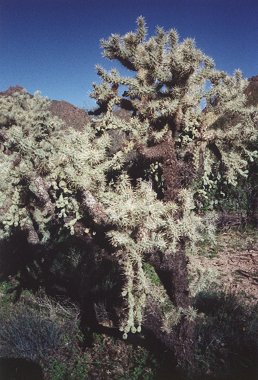Chain Fruit Cholla are members of the
Opuntia genus, a group which includes other spiny cacti like prickly
pear.
Four characteristics distinguish Opuntia from other cactus:
|
|
1.
2.
3.
4.
|
They have jointed
segments
The areoles have minute barbed spines called glochids that are
easily detachable
Rudimentary leaves are present on new joints
Their seeds have a pale covering called an aril |
Chain Fruit Cholla are a large tree-like cactus which
grows to a height of 12 feet or
 more.
It derives its name from the fact that each years fruit form on that of
the previous year, thus the length of the fruit chain increases
each year. The cactus grows at elevations from 1000 - 3000 feet and
prefers sandy desert soils of lower bajadas and valleys. In the summer,
the cholla blooms with small pink flowers. Chain Fruit Cholla are
pollinated by bees, however, they more commonly reproduce when fruit
segments drop to the ground and form roots, starting a new plant.
Because of this short dispersal distance, the cholla often form dense
colonies of clonal plants. more.
It derives its name from the fact that each years fruit form on that of
the previous year, thus the length of the fruit chain increases
each year. The cactus grows at elevations from 1000 - 3000 feet and
prefers sandy desert soils of lower bajadas and valleys. In the summer,
the cholla blooms with small pink flowers. Chain Fruit Cholla are
pollinated by bees, however, they more commonly reproduce when fruit
segments drop to the ground and form roots, starting a new plant.
Because of this short dispersal distance, the cholla often form dense
colonies of clonal plants.
|
The Chain Fruit Cholla is also
known as the jumping cholla. It gets its name from the
prickly, segmented stalks which seem to attach themselves so
easily to objects, that people thought they actually jumped
off the plant. |
Chain Fruit Cholla provide shelter for several animals
including pack rats, which often dig a nest at the base of the plant,
then cover the entrance with cholla segments for protection, and the
cactus wren, which prefer to build their nests among the stems of the
cholla. Fruits are eaten by birds and animals. Native Americans ate the
cholla buds, which contain significant protein and calcium.
|

